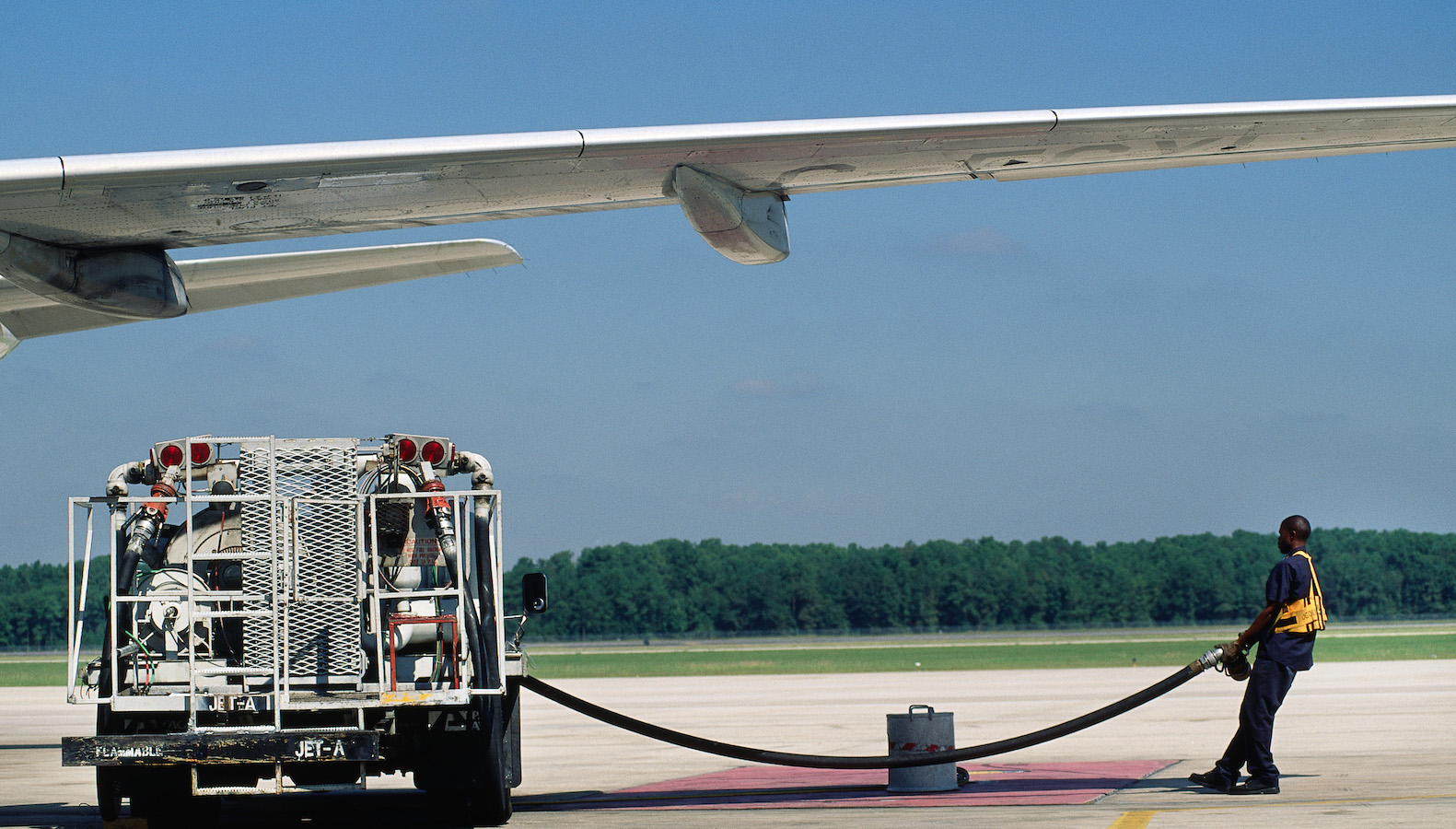This story was originally published by WIRED and is reproduced here as part of the Climate Desk collaboration.
Jet A-1, a straw-colored, kerosene-based fuel used in most big airplanes, is a difficult substance to replace. It’s packed with energy; per unit of weight, at least 60 times as much as the lithium-ion batteries used to propel electric cars. It’s also terrible for the climate. So as the aviation industry has gradually climbed aboard global pledges to get rid of carbon emissions, it has mostly promised to make up for its damage elsewhere — through offsets that might involve planting trees, restoring wetlands, or paying people to preserve ecosystems that otherwise would have been razed. But according to a growing body of research, those efforts leave something out: Most of the planet-warming effects of flying aren’t from carbon dioxide.
Burning jet fuel at 35,000 feet sparks a molecular cascade in the troposphere. The initial combustion releases a shower of particles — sulfur, nitrogen oxides, soot, and water vapor. At those frigid heights, some of the particles become nuclei around which condensation gathers and then quickly freezes, helping to produce puffy contrails that either vanish or persist as wispy, high-altitude cirrus clouds. In the presence of the sun’s rays, nitrogen molecules set of a chain of reactions that produce ozone and destroy free-floating atmospheric methane. It’s tough to pin down the meaning of all this chemistry. Some of these reactions, like the methane destruction, help cool the Earth. Others warm it. It all depends on the atmospheric conditions for each flight, multiplied across tens of thousands of planes streaking across the sky each day.
Overall, the warming effects add up. In an analysis published last year, an international team of researchers pinned 3.5 percent of total warming in 2011 on aviation alone — which may sound small, but the number has been growing fast. The authors found that roughly two-thirds of warming due to aviation at that time was caused by all of those factors that aren’t CO2 emissions.
Which is why some scientists argue that the term “carbon-neutral” doesn’t mean much, at least when it comes to flying jets. If the aviation industry wants to do its part to help meet global temperature goals, it’s better yet to think in terms of “climate-neutral,” says Nicoletta Brazzola, a climate policy researcher at ETH Zurich. In a study published this week in Nature Climate Change, she outlines all the ways to get there, including rules for more efficient flying, new technologies like low-carbon fuels and batteries, and more intensive efforts to remove carbon from the air that would go beyond canceling out aviation’s CO2 emissions, accounting for all of the industry’s warming effects. And, oh yeah: less flying. “It would require an enormous effort to meet this climate-neutrality framework solely with technology fixes and no changes to lifestyle,” she says.
So far, the industry’s focus has been on offsetting carbon. It’s the greenhouse gas we all know, and it’s easy enough to measure how burning jet fuel converts into tons of carbon emissions. That’s based on intimate knowledge of existing fuels and engines. Airlines already make those calculations and let customers see their damage — and often pay a little extra to offset those emissions through partner programs that do things like plant trees. Expecting continued growth in demand for aviation, members of the International Civil Aviation Organization, or ICAO, have pledged to hold their net carbon emissions to 2019 levels through those types of offsets. That effort itself is far from perfect — a number of investigations have found that many of the offset programs that airlines partner with chronically overestimate the amount of carbon that they successfully store. And again, those schemes are all about carbon.
In part, that’s because it’s tricky to account for all the non-CO2 factors. Atmospheric chemistry at 35,000 feet is inherently localized, dependent on factors like temperature and humidity. The greatest uncertainty is the potential behavior of contrails — the tendrils that form behind planes as water molecules condense around exhaust particles and freeze. “The basic microphysics of the ice crystals is quite difficult to get a handle on,” says David Lee, an atmospheric scientist at Manchester Metropolitan University who studies aviation emissions. If the air is humid and cool enough, they can hang around as cirrus clouds, and that would likely have a net warming effect. The time of day is another X factor. During the day, those clouds can reflect sunlight, keeping the Earth cool. But they can also trap heat, especially at night.
In theory, it might be possible to mitigate some of those effects by flying differently — avoiding particularly cold and humid patches of air, for example, or flying less often at night. But the atmospheric models the airline industry relies on aren’t good enough at predicting the exact conditions along the flight path — and there’s a risk that changing flight patterns might emit more CO2 while resulting in little benefit. “The risks of making things worse are very, very real until we can predict things better,” Lee says.
It could be better to address the emissions problems related to jet fuel directly, but finding replacements is challenging. Batteries have a long way to go before they’ll be able to pack enough energy for flight, even for short hops that carry relatively few passengers. (Though researchers are exploring more energy-dense chemistries that look beyond the lithium-ion batteries used in cars.) Another possibility is to produce sustainable jet fuels that are derived from CO2-sucking sources, like crops or algae. That would help the planes get closer to carbon neutral, because the carbon in the fuel was originally taken from the air. But there are immense logistical challenges to scaling up production of those fuels.
In the meantime, “the biggest lever you have is conserving fuel,” says Rohini Sengupta, senior manager for environmental sustainability and climate at United Airlines. In addition to cutting back on CO2 that helps mitigate the other forms of warming, she says, by reducing emissions of nitrogen and soot. The airline is also working toward to expand its use of sustainable fuels by the year 2030, and is pursuing a switch from carbon offsets to more robust carbon removal strategies to meet its 2050 carbon-neutrality goal.
In a statement, Southwest Airlines also said the company would continue to monitor non-CO2 research and pointed to its investments in sustainable jet fuels. Representatives from Delta, American, and British Airways-parent IAG did not respond to interview requests.
One good thing is that the non-CO2 effects of any particular plane streaking across the sky are short-lived. Clouds form and then fade, and molecules like ozone get destroyed by chemical processes within months. (In contrast, CO2 emissions continue to accumulate in the atmosphere for thousands of years.) This means that today’s efforts to curb non-CO2 effects will have an immediate effect on warming.
The key is keeping fuel use in check. “We’re addicted to flying, even though it’s a tiny percentage of the population that actually flies,” says Lee, who has avoided taking personal flights for the past 21 years (though business travel took him around the world before the pandemic). Asking people to change their behavior is never easy, but the current imbalance is all the more reason for those who have choices in how they travel to consider their own impact, Brazzola told me from a scorching Greek island, where she was on vacation. She had reached her destination by a complex chain of trains, buses, and boats. “It was quite the journey,” she says. But a step in the right direction.




